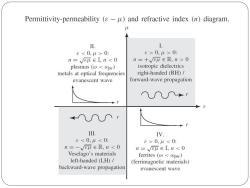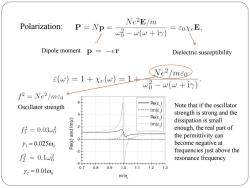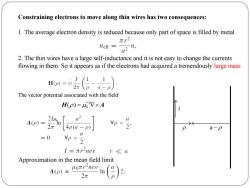电子科技大学:《近代天线理论 Modern Antenna Theory》课程教学资源(课件讲稿)拓展04 超材料原理 Metamaterials with Negative Parameters - Physics and Applications

Metamaterials with Negative Parameters:Physics and Applications
Metamaterials with Negative Parameters: Physics and Applications

Outline Theory Particle model Transmission Line model Effective Medium model Applications
Outline Theory Particle model Transmission Line model Effective Medium model Applications

Permittivity-permeability (s-u)and refractive index (n)diagram. U II. I. e0: e>0,4>0: n=E∈L,n0 plasmas(ω0,u<0: n=-√E平∈R,n<0 n=√Eu∈I,n<0 Veselago's materials ferrites(ω<wpm) left-handed (LH)/ (ferrimagnetic materials) backward-wave propagation evanescent wave

TABLE 1.1.Verification of Main Properties and Fundamental Physics of LH MTMs by Different Approaches and Different Groups. Type of Investigation References Numerical FDTD Ziolkowski et al.[27,28] Numerical FEM Caloz et al.[29] Numerical TMA Markǒs et al.[20,21] Numerical TLM So and Hoefer [30,31] Theoretical EM Lindell et al.[32],Kong et al. [33,34],Smith et al..[35], McCall et al.[36] Experimental Shelby et al.[10],Greegor (bulk)TW-SRR et al.[22],Ziolkowski [26], Marques et al.[25]Tie Jun Cui Theoretical TL Eleftheriades et al.[37,38], Caloz and Itoh [39,40], 0 liner[41,42] Experimental Iyer et al.[43],Caloz and Itoh (planar)TL [40],Sanada et al.[44]
Tie Jun Cui

Dispersive model for the dielectric permittivity -Lorentz model (particle model) A.Lna H.A.Lorentz F=-e(E+v×B), The electron in an atom can be assumed to be bound to the equilibrium position through an elastic restoring force,the equation of motion is: mi+myi+mwor =-eEo exp(-iwt), Damping force due to all inelastic processes Harmonic restoring force r =ro exp(-iwt) -eEo/m w-w(w+iy)
Damping force due to all inelastic processes The electron in an atom can be assumed to be bound to the equilibrium position through an elastic restoring force, the equation of motion is: H.A.Lorentz Dispersive model for the dielectric permittivity ——Lorentz model (particle model) Harmonic restoring force

Ne2E/m Polarization: P=Np=略-w(w+in) =0XeE, Dipole moment p=-er Dielectric susceptibility Ne2/mEo e(w)=1+Xe(w)=1+ w话-w(w+iy) f2 Ne2/meo 6 Oscillator strength Re(E,) Note that if the oscillator --lm(e,) strength is strong and the Re() (3)wl dissipation is small Im() f= 0.03w 2 pue enough,the real part of the permittivity can ⊙ 0 1=0.02500 become negative at 正 -2 frequencies just above the f=0.1娟 resonance frequency =4 0.7 0.8 0.9 1.01.11.21.3 Y2=0.010 00
Polarization: Dipole moment Dielectric susceptibility Oscillator strength 1 0 0.025 2 0 0.01 Note that if the oscillator strength is strong and the dissipation is small enough, the real part of the permittivity can become negative at frequencies just above the resonance frequency

Metal and plasmons at optical frequency The motion for an electron in a time harmonic electric field is: mi+myi =-eEo exp(-iwt), P=(e-1)EoE--Ncr=_ e2/mE (w+iy) plasma frequency e(u)=1- Ne2/(com) w w(w+iy)】 -1- w(w+iy) Evanescence Propagation -Re(k/k。) 。 Im(k/k -Re(E) -Im() k2c2+w2=w2 10 2 3 00p 0/0. Dispersion of light in a good plasma
Metal and plasmons at optical frequency The motion for an electron in a time harmonic electric field is: Dispersion of light in a good plasma

Thin wire structures as low frequency negative permittivity (Pendry 1996) For many metals,the plasma frequency is at ultraviolet frequencies and y is small compared with.However,the dissipation in most metals is very large,so we have trouble when try to extend this behavior to low frequencies. In 1996,Pendry proposed that thin metallic wires behave as a low frequency plasma with a frequency stop-band from zero up to a cutoff frequency.The low frequency stop-band can be attributed to negative dielectric permittivity and the cutoff frequency to the plasma frequency. 个E
For many metals, the plasma frequency is at ultraviolet frequencies and is small compared with . However, the dissipation in most metals is very large, so we have trouble when try to extend this behavior to low frequencies. p Thin wire structures as low frequency negative permittivity (Pendry 1996) In 1996, Pendry proposed that thin metallic wires behave as a low frequency plasma with a frequency stop-band from zero up to a cutoff frequency. The low frequency stop-band can be attributed to negative dielectric permittivity and the cutoff frequency to the plasma frequency. E

Constraining electrons to move along thin wires has two consequences: 1.The average electron density is reduced because only part of space is filled by metal 元r2 neff a2 n, 2.The thin wires have a large self-inductance and it is not easy to change the currents flowing in them.So it appears as if the electrons had acquired a tremendously large mass H=品(日。) The vector potential associated with the field H(p)=67×A aoi=[nn] a yp< a-p =0 p 2 I=πr2nev r<a Approximation in the mean field limit A(p)≈lonr2neu 2π \p】
Constraining electrons to move along thin wires has two consequences: 1. The average electron density is reduced because only part of space is filled by metal 2. The thin wires have a large self-inductance and it is not easy to change the currents flowing in them. So it appears as if the electrons had acquired a tremendously large mass a I 1 0 ( ) H A The vector potential associated with the field Approximation in the mean field limit 0

We note that the canonical momentum of an electron in an electromagnetic field is p +eA.Thus assuming that the electrons flow on the surface of the wire (assuming a perfect conductor),we can associate a momentum per unit length of the wire of mentr2nv and thus an effective mass of uoπr2ne2 meff= 2元 we i() for the electron. Thus,assuming a longitudinal plasmonic mode for the system,we have neme2 2元c2 0p= Eomeff a2In(a/r) Typically one can chooser =1 um,a 10 mmand aluminium wires (n 1029 m-3), which gives an effective mass of mem=2.67×10-26kg, that is almost 15 times that of a proton,and a plasma frequency of about 2 GHz!Thus,we have succeeded in obtaining a negative dielectric material at microwave frequencies
按次数下载不扣除下载券;
注册用户24小时内重复下载只扣除一次;
顺序:VIP每日次数-->可用次数-->下载券;
- 电子科技大学:《近代天线理论 Modern Antenna Theory》课程教学资源(课件讲稿)拓展03 电磁超材料.pdf
- 电子科技大学:《近代天线理论 Modern Antenna Theory》课程教学资源(课件讲稿)拓展02 EBG结构 Electromagnetic Band Gap Structure in Antenna Application.pdf
- 电子科技大学:《近代天线理论 Modern Antenna Theory》课程教学资源(课件讲稿)拓展01 电小天线 Electrically Small Antenna Design.pdf
- 电子科技大学:《近代天线理论 Modern Antenna Theory》课程教学资源(课件讲稿)10 天线前沿动态.pdf
- 电子科技大学:《近代天线理论 Modern Antenna Theory》课程教学资源(课件讲稿)09 信号处理天线.pdf
- 电子科技大学:《近代天线理论 Modern Antenna Theory》课程教学资源(课件讲稿)08 相控阵天线.pdf
- 电子科技大学:《近代天线理论 Modern Antenna Theory》课程教学资源(课件讲稿)07 宽带天线及移动通信天线.pdf
- 电子科技大学:《近代天线理论 Modern Antenna Theory》课程教学资源(课件讲稿)06 微带天线简介.pdf
- 电子科技大学:《近代天线理论 Modern Antenna Theory》课程教学资源(课件讲稿)05 全局优化算法在天线阵综合中的应用.pdf
- 电子科技大学:《近代天线理论 Modern Antenna Theory》课程教学资源(课件讲稿)04 阵列分析与综合.pdf
- 电子科技大学:《近代天线理论 Modern Antenna Theory》课程教学资源(课件讲稿)03 常用数值方法及其商用软件介绍.pdf
- 电子科技大学:《近代天线理论 Modern Antenna Theory》课程教学资源(课件讲稿)02 典型辐射问题的解析方法.pdf
- 电子科技大学:《近代天线理论 Modern Antenna Theory》课程教学资源(课件讲稿)01 常见天线及应用简介.pdf
- 电子科技大学:《无线系统中的微波与射频 Microwave and RF Design in Wireless Systems》课程教学资源(课件讲稿)ch10 Receiver Design 接收机设计.pdf
- 电子科技大学:《无线系统中的微波与射频 Microwave and RF Design in Wireless Systems》课程教学资源(课件讲稿)ch09 Modulation Techniques 调制技术.pdf
- 电子科技大学:《无线系统中的微波与射频 Microwave and RF Design in Wireless Systems》课程教学资源(课件讲稿)ch08 Transistor Oscillators And Frequency Synthesizers.pdf
- 电子科技大学:《无线系统中的微波与射频 Microwave and RF Design in Wireless Systems》课程教学资源(课件讲稿)ch07 Mixers.pdf
- 电子科技大学:《无线系统中的微波与射频 Microwave and RF Design in Wireless Systems》课程教学资源(课件讲稿)ch06 Amplifiers 放大器.pdf
- 电子科技大学:《无线系统中的微波与射频 Microwave and RF Design in Wireless Systems》课程教学资源(课件讲稿)ch05 Filter.pdf
- 电子科技大学:《无线系统中的微波与射频 Microwave and RF Design in Wireless Systems》课程教学资源(课件讲稿)ch04 Antennas and Propagation for Wireless System.pdf
- 电子科技大学:《数字信号处理方法及应用 Methods and Applications of Signal Processing》课程教学资源(教学大纲).pdf
- 电子科技大学:《信号处理理论与算法》课程教学资源(课件讲稿)第一部分 CH01 绪论(主讲:刘科).pdf
- 电子科技大学:《信号处理理论与算法》课程教学资源(课件讲稿)第一部分 CH02 离散时间信号与系统分析基础(离散傅里叶变换及快速算法).pdf
- 电子科技大学:《信号处理理论与算法》课程教学资源(课件讲稿)第一部分 CH03 离散傅里叶变换与快速算法.pdf
- 电子科技大学:《信号处理理论与算法》课程教学资源(课件讲稿)第一部分 CH04 数字滤波器的基本结构.pdf
- 电子科技大学:《信号处理理论与算法》课程教学资源(课件讲稿)第一部分 CH05 IIR滤波器设计.pdf
- 电子科技大学:《信号处理理论与算法》课程教学资源(课件讲稿)第一部分 CH06 FIR滤波器设计.pdf
- 电子科技大学:《信号处理理论与算法》课程教学资源(课件讲稿)第二部分 CH01 随机信号的相关和功率谱分析.pdf
- 电子科技大学:《信号处理理论与算法》课程教学资源(课件讲稿)第二部分 CH02 非参数功率谱估计(主讲:张朋).pdf
- 电子科技大学:《信号处理理论与算法》课程教学资源(课件讲稿)第三部分 CH01 时频分析——信号分析基础.pdf
- 电子科技大学:《信号处理理论与算法》课程教学资源(课件讲稿)第二部分 CH03 参数模型功率谱估计.pdf
- 电子科技大学:《信号处理理论与算法》课程教学资源(课件讲稿)第二部分 CH04 自适应滤波.pdf
- 电子科技大学:《信号处理理论与算法》课程教学资源(课件讲稿)第三部分 CH02 短时傅里叶变换与Gabor变换.pdf
- 电子科技大学:《信号处理理论与算法》课程教学资源(课件讲稿)第三部分 CH03 Wigner分布.pdf
- 电子科技大学:《信号处理理论与算法》课程教学资源(课件讲稿)第三部分 CH04 Cohen类时频分布.pdf
- 电子科技大学:《信号处理理论与算法》课程教学资源(课件讲稿)第四部分 CH01 现代信号处理——信号的抽取和插值.pdf
- 电子科技大学:《信号处理理论与算法》课程教学资源(课件讲稿)第四部分 CH02 滤波器组基础.pdf
- 电子科技大学:《信号处理理论与算法》课程教学资源(课件讲稿)第四部分 CH03 两通道滤波器组.pdf
- 电子科技大学:《图像处理及应用 Image Processing and Application》课程教学资源(课件讲稿)Chapter 01 Introduction of Digital Image Processing(张萍).pdf
- 电子科技大学:《图像处理及应用 Image Processing and Application》课程教学资源(课件讲稿)Chapter 02 数字图像处理基础 Fundamentatals of Digital Image.pdf
